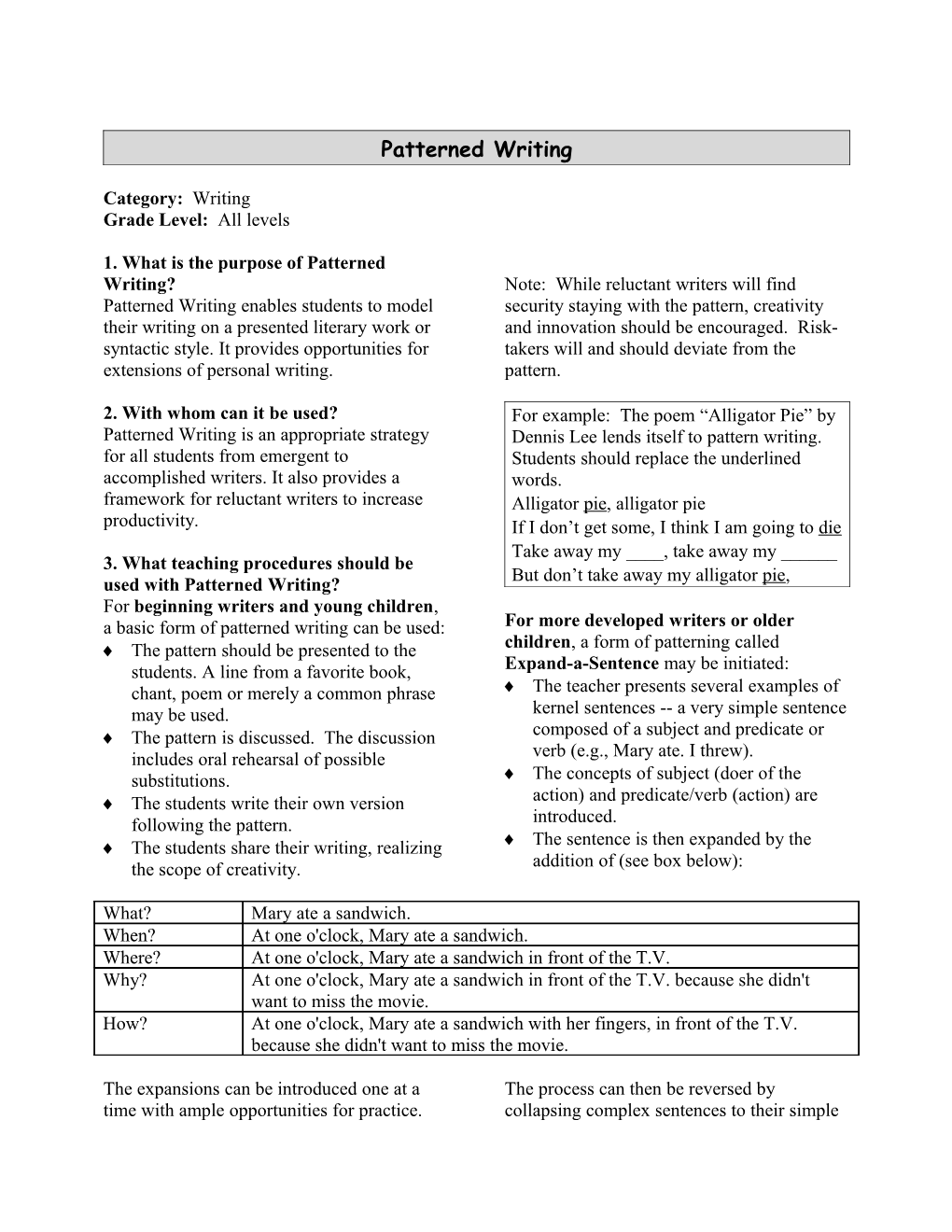Patterned Writing
Category: Writing
Grade Level: All levels
1. What is the purpose of Patterned Writing?
Patterned Writing enables students to model their writing on a presented literary work or syntactic style. It provides opportunities for extensions of personal writing.
2. With whom can it be used?
Patterned Writing is an appropriate strategy for all students from emergent to accomplished writers. It also provides a framework for reluctant writers to increase productivity.
3. What teaching procedures should be used with Patterned Writing?
For beginning writers and young children, a basic form of patterned writing can be used:
The pattern should be presented to the students. A line from a favorite book, chant, poem or merely a common phrase may be used.
The pattern is discussed. The discussion includes oral rehearsal of possible substitutions.
The students write their own version following the pattern.
The students share their writing, realizing the scope of creativity.
Note: While reluctant writers will find security staying with the pattern, creativity and innovation should be encouraged. Risk-takers will and should deviate from the pattern.
For example: The poem “Alligator Pie” by Dennis Lee lends itself to pattern writing. Students should replace the underlined words.
Alligator pie, alligator pie
If I don’t get some, I think I am going to die
Take away my ____, take away my ______
But don’t take away my alligator pie,
For more developed writers or older children, a form of patterning called Expand-a-Sentence may be initiated:
The teacher presents several examples of kernel sentences -- a very simple sentence
composed of a subject and predicate or verb (e.g., Mary ate. I threw).
The concepts of subject (doer of the action) and predicate/verb (action) are introduced.
The sentence is then expanded by the addition of (see box below):
What? / Mary ate a sandwich.When? / At one o'clock, Mary ate a sandwich.
Where? / At one o'clock, Mary ate a sandwich in front of the T.V.
Why? / At one o'clock, Mary ate a sandwich in front of the T.V. because she didn't want to miss the movie.
How? / At one o'clock, Mary ate a sandwich with her fingers, in front of the T.V. because she didn't want to miss the movie.
The expansions can be introduced one at a time with ample opportunities for practice.
The process can then be reversed by collapsing complex sentences to their simple form. Words, phrases and clauses are extracted in a reverse procedure.
4. In what type of settings can Patterned Writing be used?
Patterned Writing is effective in formalized whole class instruction or on an individualized basis. A situation may occur during a writing conference where sentence expansion is needed.
5. To what extent has research shown Patterned Writing to be useful?
Patterned Writing has proven to be a basic tool in writing instruction. It offers the security of structure while allowing creativity and risk-taking.
References
- Tierney, R.I., Readence, I.E., & Dishner, E.K. (1985). Reading strategies and practices: A compendium. Massachusetts: Allyn & Bacon.
- White, R.S. & Karl, H. (1980). Reading, writing and sentence combining: The track record. Reading Improvement, 17, 226-232.
